Welcome to the Hohenlohe tourist region
A particularly delicately formed handful of Germany
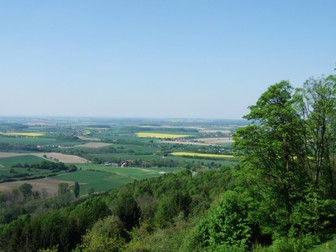
...idyllic, full of poetry, a particularly delicately formed handful of Germany, this is the way in which the poet Eduard Mörike described Hohenlohe.
Little has changed since then. Wooded hills reaching into the fertile Plain of Hohenlohe, wide valleys surrounded by vinyards, quiet brooks, gently rolling hills, mixed forests, numerous small lakes and the main rivers Kocher and Jagst, all these give Hohenlohe's landscape its particular character.
Hohenlohe Land is situated in north-eastern Baden-Württemberg and consists mainly of the rural districts of Schwäbisch Hall and Hohenlohe.
...idyllic, full of poetry, a particularly delicately formed handful of Germany, this is the way in which the poet Eduard Mörike described Hohenlohe.
Little has changed since then. Wooded hills reaching into the fertile Plain of Hohenlohe, wide valleys surrounded by vinyards, quiet brooks, gently rolling hills, mixed forests, numerous small lakes and the main rivers Kocher and Jagst, all these give Hohenlohe's landscape its particular character.
Hohenlohe Land is situated in north-eastern Baden-Württemberg and consists mainly of the rural districts of Schwäbisch Hall and Hohenlohe.
IIlustrious tourist routes
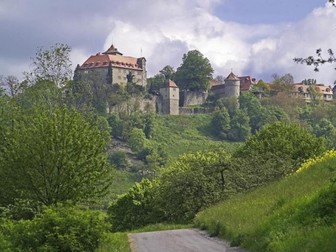
IIlustrious tourist routes pass through Hohenlohe: The "Castle Route", the "Idyllic Route", the "German Holiday Route from the Alps to the Baltic", the "Swabian Wine Route" and the "Swabian Poets' Route". One can also arrive by the A6, A7, and A81 or by rail, air or bus.
It would, however, be a mistake to think that Hohenlohe is made up entirely of transit routes. No traveller should afford to miss the beauty and originality of Hohenlohe itself.
The castles and palaces
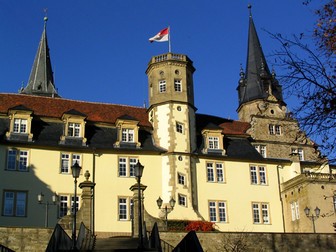
Let us start with the castles and palaces. Some of them have retained their lordly splendour while others are now only ruins, around which many legends have grown up. The region was named the "Land of Castles and Palaces" on account of the great number of historic buildings to be found here.
The Hohenloher have, to a great extent, succeeded in preserving the original appearance of the country-side and the towns and villages. Medieval townscapes, living village communities, quiet natural beauty spots, clean air, a wealth of flora and fauna and many things of beauty which, as is so often the case, are only to be found in more remote areas.
Hohenlohe, however, also stands for a variety of Cultural activities, friendly people and pastimes to suit every taste.
Historic
The fortified wall
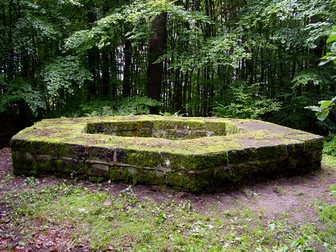
Before the word Hohenlohe had ever been heard of, the Romans built their fortified wall, the Limes, through the area which was then inhabited by Germanic tribes. Remains bearing witness to the Roman occupation are to be seen both in the open countryside and carefully preserved in museums.
The word Hohenlohe was first mentioned a little less than a thousand years ago when the noble family zu Hohenlohe acquired power and influence in the area. Wherever a member of the family settled a castle or palace was built.
The relationship between the population and its rulers was so close that the former assumed the rulers' name and called themselves Hohenloher.
Götz of the Iron Hand
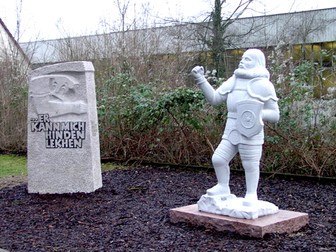
The bond remained strong even after 1806 when Napoleon and the House of Württemberg occupied Hohenlohe and put an end to the principalities and the modern Hohenloher still has a special relationship to "his" prince.
The famous knight, Götz von Berlichingen, immortalized by Goethe, is also part of Hohenlohe`s history. Götz of the Iron Hand took part in the Knights War from Krautheim in the Jagst valley. He relucatantly attended school in Niedernhall and was buried, after an eventful life, in Schöntal Monastery.
Coat of Arm
Description of the Coat of Arms of the District of Hohenlohe
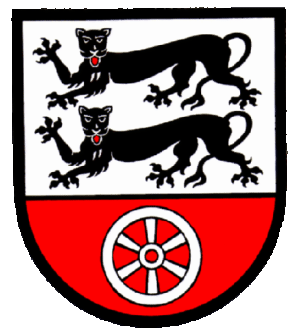
District of Hohenlohe. - Coat of Arms: In silver (white) above an elevated red escutcheon foot, inside of it a silver (white) six-spoked wheel as well as two striding, red-tounged, black lions (leopards) with a bowed tail, both of them looking to the front.
The District of Hohenlohe was created out of the former Districts of Kuenzelsau and Oehringen and parts of the former Districts of Buchen, Schwaebisch Hall and Crailsheim as part of the district reform act of 1973. The newly created District of Hohenlohe chose a coat of arms that is dominated by the heraldry animals of the House of Hohenlohe, alluding to the district’s name and the preeminent position of the House of Hohenlohe in the history of the region.
The wheel (Wheel of Mainz) positioned in the escutcheon foot points at the former close affiliation between some parts of the region, especially the region around Krautheim, and the archdiocese of Mainz. The coat of arms was granted by the Ministry of the Interior on April 3rd 1974.
The usage of the coat of arms needs the express permission of the county management of the District of Hohenlohe, the County Manager’s Office.
Holiday and leisure
Fun, amusement and variety
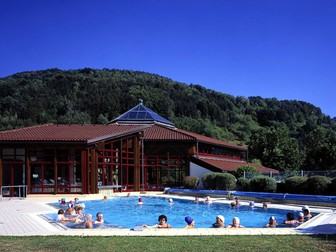
Fun, amusement and, of course, variety are all part of a relaxing holiday in Hohenlohe.
There are attractive paths for ramblers and cyclists, mail-coach rides in an elegant carriage-and-four or rides of the narrowgauge railway in the romantic Jagst valley.
Hohenlohe can be seen from above during a balloon ride or while hanggliding, and a refreshing swim is always welcome afterwards. Very important: In the Hohenlohe countryside children can enjoy their games in natural surroundings.
Quietness and seclusion are also to be found in Hohenlohe. Just as fishermen like to retire to quiet places to make their best catch, we have many secluded spots where one can escape the hustle and bustle. Consult the leisure map for further details.
Natural landscape and healthy air

Hohenlohe's natural landscape and healthy air have combined to make it a centre tor relaxation and convalescence.
There are 8 state-approved recreational resorts and 3 climatic health-resorts. Schwäbisch Hall and Niedernhall have modern salt-water swimming-baths with medicinal mineral springs. Visitors are welcome everywhere.
Hohonlohe´s cultural scene

Open-air theatre enjoys great popularity in Hohenlohe. Schwäbisch Hall, Jagsthausen and Stetten Castle are venues for plays during the summer months. Classical music in historic surroundings is to be heard at he concerts of the "Hohenlohe Culture Summer" which was originated in Schöntal Monastery.
Castles, palaces, monasteries and churches are turned into concert-halls for the music-lover. Modern music also plays an important part in Hohonlohe´s cultural scene, as do art exhibitions, poetry readings, puppet-theatre and demonstrations of old handcrafts.
Variety of museums
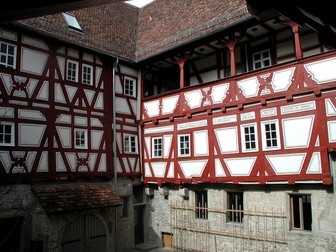
The fact that museums need not necassarily be boring is proved by the sheer variety of the collections that are to be seen: Palace and castle museums, the Motor Museum, the geological Shell Limestone Museum, the Local History Museum or the museum for old handcrafts, every visitor will find something of interest.
The castle and palace museums document the history of life within noble walls, whereas, in the open-air museum at Wackershofen, the life and work of the farming community is shown.
Hohenlohe's many churches, of which it is said that no two spires are similar, are well worth seeing. Collections of dolls, the Military Museum, the Pewter Museum, the Roman Museum, the Excavation Museum and many more, are all further spashes of colour on the multicoloured pallette of museums to be found in the towns and villages of Hohenlohe.
festivals and wine
Various festivals

The Hohenloher are a hard-working people who like to work just as hard at celebrating - and opportunities are not lacking.
The various festivals celebrating historic events are very popular, and market and fair days are also an excuse for a celebration. Conviviality plays an important part in life here. The castles, palaces and ruins provide a picturesque background.
It is not only the "big" festivals, which are popular but also the innumerable village and country festivals. Originality and love of festivity have remained undiminished up today. This also applies to the "spirited" wine festivals.
Hohenlohe wine and beer
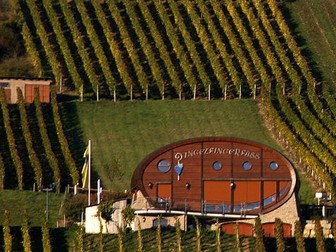
It need hardly be mentioned that on these occasions Hohenlohe wine is served. The "variety of flavour and high standard" of this "special wine from Württemberg" has been vouched for.
Apart from the vinyards, wich have formed the landscape of Hohenlohe, an excellent beer is also produced. Brewed according to original recipes and corresponding to German standards, it, like the wine, can be enjoyed in cultivated surroundings.
You can raise your glass to that!
